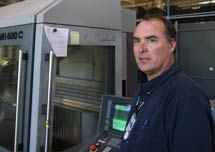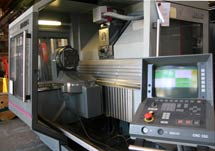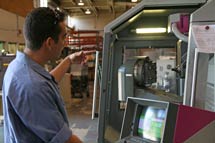
Handy Links
SLAC News Center
SLAC Today
- Subscribe
- Archives: Feb 2006-May 20, 2011
- Archives: May 23, 2011 and later
- Submit Feedback or Story Ideas
- About SLAC Today
SLAC News
Lab News
- Interactions
- Lightsources.org
- ILC NewsLine
- Int'l Science Grid This Week
- Fermilab Today
- Berkeley Lab News
- @brookhaven TODAY
- DOE Pulse
- CERN Courier
- DESY inForm
- US / LHC
SLAC Links
- Emergency
- Safety
- Policy Repository
- Site Entry Form

- Site Maps
- M & O Review
- Computing Status & Calendar
- SLAC Colloquium
- SLACspeak
- SLACspace
- SLAC Logo
- Café Menu
- Flea Market
- Web E-mail
- Marguerite Shuttle
- Discount Commuter Passes
-
Award Reporting Form
- SPIRES
- SciDoc
- Activity Groups
- Library
Stanford
Around the Bay
People: SLAC MFD and the Five-axis Mill
Walking through the Heavy Fabrication Building can feel a little bit like walking through a museum of industrial technology. There's an enormous floor mill reputedly used to build tanks in WWII, a repurposed battleship turret that now serves as a coil winding tool, and an old vacuum chamber that looks as though it came from the world of Jules Verne.
Amidst all these venerable giants, though, is something of a modern marvel—a device called a five-axis mill. It's the latest addition to the Mechanical Fabrication Department’s suite of machines, and according to Machine Maintenance Supervisor Kelley Ramsey, something that could significantly boost the shop's capabilities.
"This is the mother of machines," Ramsey said. "You can make anything with these."
A mill is a machine tool used to shape different materials. Mills are commonly used to produce parts for research and design projects around the lab, from accelerator components to parts for scientific instruments. Researchers and engineers send specifications for a part they need to the fabrication shop, machinists enter the specifications into a mill's onboard computer, and the mill works its way back and forth, cutting away to produce the desired form.
Most mills, though, are limited by their range of movement. The oldest mills in SLAC's shop simply move a piece of metal back and forth against a fixed cutting tool. As Kelley Ramsey described, the models can be somewhat akin to an Etch-a-Sketch in their operation—something that, as anyone who has tried drawing a circle on an Etch-a-Sketch knows, is not an altogether flattering comparison.
Newer mills add more versatility by introducing amenities such as free-moving cutting tools and rotating platforms. Working on multiple sides of an object can still be tricky though. Machinists frequently have to manually reposition the object they're working on in order to get full exposure to the cutting tool.
Five-axis mills overcome these challenges by actually picking up the pieces being worked on, manipulating them in space to give the cutting tool access to all sides of an object. Given a skilled machinist and proper instructions, a five-axis mill can produce complex shapes in a single go.
According to Ramsey, the mill's flexibility will increase the scope of work that the Machine Shop is able to do and will allow them to process complicated jobs faster than they could otherwise. For the fabrication shop's customers, having access to the tool—which can work from starting materials as large as 23.6 by 17.7 inches—could make the difference between being able to get a job done at SLAC as opposed to shipping it off site.
The mill's current home in the Heavy Fabrication Building is only a test location until a larger and more temperature-controlled space can be found. The Mechanical Fabrication Department is also working to develop employee expertise in using the tool; Ramsey said that while the shop can process some very basic jobs with the tool, more training needs to be done in order to take full advantage of the machine.
"We're almost there," he said.
—Nicholas Bock
SLAC Today, August 19, 2009


